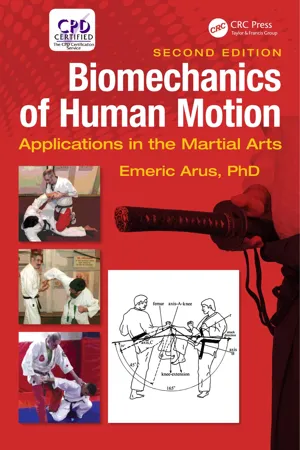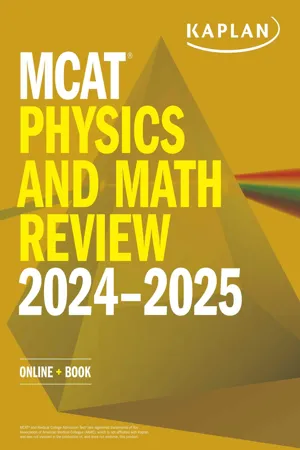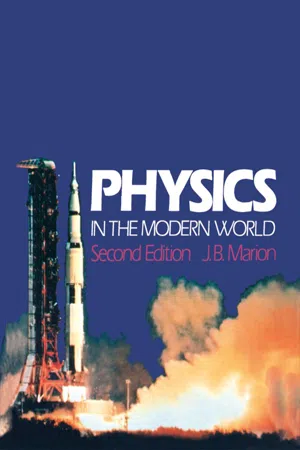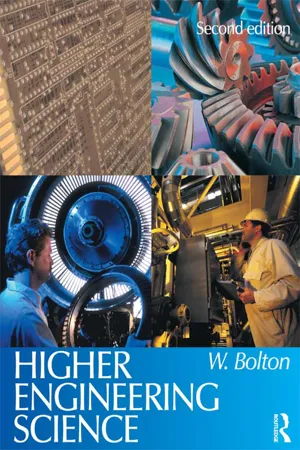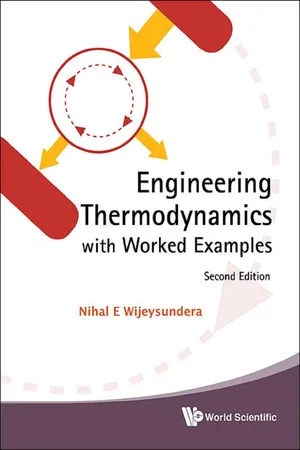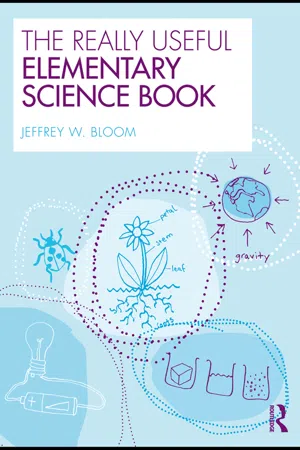Physics
Work and Kinetic Energy
Work is the transfer of energy that occurs when a force is applied to an object and it moves in the direction of the force. Kinetic energy is the energy an object possesses due to its motion. The work-energy theorem states that the work done on an object is equal to the change in its kinetic energy.
Written by Perlego with AI-assistance
Related key terms
Related key terms
1 of 4
Related key terms
1 of 3
12 Key excerpts on "Work and Kinetic Energy"
- No longer available |Learn more
- Robert A. Pelcovits, Joshua Farkas(Authors)
- 2023(Publication Date)
- Barrons Educational Services(Publisher)
We have discussed qualitatively how the sign of work is related to the change in an object’s speed (forces that exert positive work increase speed, forces that exert negative work decrease speed, and forces that exert zero work do not affect speed). Now we would like to define this relationship mathematically. We start with the definition of work and integrate to obtain the total work:If the net force is not constant, we must first express the integrand in terms of one variable and its own differential (this is similar to separating variables when solving air resistance problems in the last chapter). In this case, the manipulations are a little more tricky:Rearranging, Now the right side is ready to integrate: It is composed of two integrands, each of which is defined by a different variable and its own differential.Given the definition of speed as , this can be rewritten asWe are thus led to define a new quantity, the kinetic energy:Definition of kinetic energySimilar to work and other forms of energy, kinetic energy has units of joules (J = N · m = kg · m2 /s2 ).Work–Kinetic Energy Theorem
Now we can appreciate the physical significance of work rather than viewing it simply as a mathematical definition: Work is the change in an object’s kinetic energy due to the action of a given force.Work–kinetic energy theoremThis is the first and most fundamental of a number of equations we will soon derive relating various types of work and energy. This theorem is a restatement of Newton’s laws, and it is always valid.TIP This theorem is another way of stating Newton’s second law.Example 4.2A force acts on an object of mass 2 kg as it moves from x = 0 to x = 5 m. Given that the object is at rest at x = 0,(a)Calculate the net work. (b)What is the final speed of the object?Solution(a)(b)Conservative and Nonconservative Forces
The Law of Conservation of Energy
Energy is never created or destroyed; it merely changes form. The total energy of an isolated system is constant when all forms of energy are accounted for (e.g., sound, light, heat, KE). - eBook - ePub
Biomechanics of Human Motion
Applications in the Martial Arts, Second Edition
- Emeric Arus, Ph.D.(Authors)
- 2017(Publication Date)
- CRC Press(Publisher)
v the velocity squared. Kinetic energy is a scalar quantity that has magnitude and no direction. The kinetic energy is totally described by magnitude alone. The method to measure kinetic energy is the same as that for the potential energy, whose unit is the joule (J).Let us take an example from karate for kinetic energy. Calculate the KE of a 70-kg-mass karateka’s kick from a natural position (both legs are parallel to each other) at 9.9 m/s. The distance is not specified and the speed has been registered as an average speed. The kicking distance usually is about 95 cm or a little bit more than 1 m. We did not take into consideration that the kick is executed against gravity.The equation is KE = 1/2 m ⋅ v 2 = 1/2(70 kg) × 9.9 m2 = 3430 J.8.6.2 WorkWork and energy link together and have a common usage. The daily work that people do requires energy. People moving objects, or simply walking, which requires energy, are examples of work too. A thinking process also means working. The work is a scalar quantity and is a product of magnitude of force needed to overcome a resistance and the displacement over which the force is applied (the object moved). Work (W ) = F ⋅ s or N ⋅ m, also expressed in joule, where s = displacement.As mentioned earlier, energy and work have a common usage in mechanics and in general. Here is the so-called work–energy relationship that is related to physical work: This relationship states that the amount of work done is equal to the change in energy.W = ΔKE + ΔKE ang + ΔPE , where ΔKE is the change in kinetic energy, ΔKE ang is the change in angular energy, and ΔPE is the change in potential energy.Work can also be described as the change of energy to another form of energy. This form of changing is also called transduction.8.6.2.1 Concept of Work Related to ForceA person or an object can do positive or negative work. When the force acts in the same direction as the displacement, then the work done is positive. On the contrary, when the force acts in the opposite direction to the displacement, then the work done is negative. For example, when a weight lifter lifts a barbell overhead in one continuous movement, he exerts a positive work - eBook - ePub
- Robert Lambourne(Author)
- 2019(Publication Date)
- CRC Press(Publisher)
Before moving on to consider work and its relation to kinetic energy, it is worth saying that since the conservation of energy implies the possibility of ‘exchanging’ one form of energy for another, it must be the case that all forms of energy are scalar quantities and that they can all be measured in joules. In short, we can say quite generally that energy is a scalar quantity and that its SI unit is the joule.2.2 Work and changes in kinetic energyThe relationship between speed and translational kinetic energy implies that any change in a body’s speed must be accompanied by a corresponding change in its translational kinetic energy. However, we already know that a change of speed involves a change of velocity and hence (by Newton’s first law) the action of an unbalanced force. So the application of a force to a body can bring about a change in its translational kinetic energy.Since the energy of a body is a measure of its capacity to do work, any change in the energy must represent a change in the work that can be done. As these changes in its capacity to do work have been caused by the action of a force, it makes sense to say that they represent the work done on the body by the force. We are thus led to the following general statement:The work done on a body by any force is the energy transferred to or from that body by the action of the force.In the case of a particle, we have the work–energy theorem, which asserts that:The change in the translational kinetic energy of a particle is equal to the work done by the total force that acts upon it.So, if the total force on a particle causes it to change its speed from an initial value u to a final value v , then the work–energy theorem tells us that the amount of work done by that total force isW = Δ(2.2)E trans=1 2mv 2−1 2mu 2where the symbol ΔE trans represents the change in translational kinetic energy, the result of subtracting the initial value from the final value. Note that although the initial and final kinetic energies must both be positive, their difference may be positive or negative, depending on whether the force causes the particle to speed up or to slow down. In other words, the work done by the total force may be positive or negative. Also note that this relation applies to the work done by the total force. A typical body is usually subject to several forces simultaneously, some of which do positive work while others do negative work. Equation 2.2 only applies to the work done by the total - No longer available |Learn more
MCAT Physics and Math Review 2024-2025
Online + Book
- (Author)
- 2023(Publication Date)
- Kaplan Test Prep(Publisher)
Chemical and Physical Foundations of Biological Systems section. We also covered the application of energy and work with simple machines, such as levers, inclined planes, and pulleys. These devices assist us in accomplishing work by reducing the forces necessary for displacing objects.Preparing for the MCAT is hard (mental) work, but you are well on your way to achieving success on Test Day. This MCAT Physics and Math Review book (and all the materials provided in your Kaplan program) is part of a set of tools—your simple machines, if you will—that will provide you with the mechanical advantage to ease your efforts toward a higher score.GO ONLINE
You’ve reviewed the content, now test your knowledge and critical thinking skills by completing a test-like passage set in your online resources!CONCEPT SUMMARY
Energy
- Energy is the property of a system that enables it to do something or make something happen, including the capacity to do work. The SI units for all forms of energy are joules (J).
- Kinetic energy is energy associated with the movement of objects. It depends on mass and speed squared (not velocity).
- Potential energy is energy stored within a system. It exists in gravitational, elastic, electrical, and chemical forms.
- Gravitational potential energy is related to the mass of an object and its height above a zero-point, called a datum
- eBook - ePub
- Jerry Marion(Author)
- 2012(Publication Date)
- Academic Press(Publisher)
movement . To make use of the potential energy possessed by an object, the potential energy must first be converted into motional energy. If we drop an object from a certain height, we know that it will accelerate due to gravity and will strike the floor with a certain velocity. The greater the height from which the object is dropped, the greater will be its impact velocity and the greater will be the kinetic energy and the amount of work that can be done.We can define the energy concept in the following way:Energy is the capacity to do work.The potential energy of a raised block, Mgh , can be converted into an equal amount of work. The potential energy is first converted into kinetic energy, Mv 2 = Mgh , and the kinetic energy is then converted into work by driving the stake into the ground. The net result of the operation is to use the original amount of potential energy to drive the stake.Conservation of Energy—Forms of Energy
In the example of the falling block, no energy is lost in any phase of the process. Work is done on the block and the block possesses this amount of energy—in the form of potential and/or kinetic energy—until the energy is given up when the block does an equivalent amount of work on the stake. The energy delivered to the stake is finally converted into heat and sound energy. Although energy is converted from one form to another, no energy is lost—energy is conserved . This important concept is summarized by the equation(7-14)E initial=E final=( K .E . + P .E . )initial( K .E . + P .E . )final(7-14)Every process known in Nature takes place in accordance with the principle of energy conservation. But the true importance of this principle cannot be fully understood or appreciated unless it is realized that energy appears in many forms. If we add up all of the energy in its various forms that an isolated system possesses before an event or process takes place and do the same afterward, we always find an exact balance. We can make this calculation only if we know all of the ways in which energy can appear. If we did not realize the existence of electric energy, for example, we would discover many situations in which there is an apparent increase or decrease in energy. - eBook - ePub
- William Bolton(Author)
- 2012(Publication Date)
- Routledge(Publisher)
5 Energy transfer5.1 IntroductionThis chapter is concerned with the energy transfers that can occur with mechanical systems. Energy can be transferred from one form to another by work being done or by heat transfer. Here we restrict the discussion to transfers involving work. There are many forms that energy can take and in this chapter potential energy, linear and angular kinetic energy and strain energy are discussed and the principles applied to the solution of mechanical system problems.5.1.1 Conservation of energyThere is a basic principle that is used in all discussions of energy and that is that energy is never lost, it is only transformed from one form to another or transferred from one object to another. This is the principle of the conservation of energy. In any process we never increase the total amount of energy, all we do is transform it from one form to another.5.2 WorkThe principle of the conservation of energy is that energy is never created or lost but only converted from one form to another. In all such conversions, the total amount of energy remains constant.Work is said to be done when the energy transfer takes place as a result of a force pushing something through a distance (Figure 5.1 ), the amount of energy transferred W being the product of the force F and the displacement s of the point of application of the force in the direction of the force.Figure 5.1 WorkWith force in newtons and distance in metres, the unit of work is the joule (J) with 1 J being 1 N m.Work done by a constant force W = Fs [1] Consider the work done by a force F when the resulting displacement s is at some angle 0 to the force (Figure 5.2 ). We can look at this in two equivalent ways. We can consider the displacement in the direction of the force F is s cos θ and so the work done is:work done = F × s cos θ [2] Figure 5.2 An oblique forceAlternatively, we can consider the force component acting in the direction of the displacement. The force can be resolved into two components, namely F cos θ in the direction of the displacement and F sin θ at right angles to it. There is no displacement in the direction of the F sin θ component and so it does no work. Hence the work done by the oblique force is solely due to the F cos θ - eBook - ePub
- Nihal E Wijeysundera(Author)
- 2016(Publication Date)
- WSPC(Publisher)
chapter 1 on the attributes of properties, we conclude that the kinetic energy is a property of the body.To evaluate the work done on the body, using the left hand side of Eq. (3.2) , we need to know how the force F varies with the displacement x . Therefore, the work done by the force is, in general, path-dependent. However, for certain forces like the gravitational force, the work done in moving the body from one point to another is independent of the path followed. Such a force is called a conservative force .The vector form of the expression for work done can be written aswhere F and are the force and position vectors respectively. The work, W however, is a scalar quantity. Note that the common units of work may be expressed as: [W ] = Nm (Newton-meter) = J (Joule).3.2Work Interactions in Thermodynamics
The interactions of a thermodynamic system with its surroundings occur at the system boundary. These interactions are usually the result of pressure forces, electrical currents, surface tension forces and others. For a concise formulation of the laws of thermodynamics we categorize all boundary interactions under two broad headings. These are called work interactions and heat interactions .3.2.1Criterion for a work interaction
It is possible to develop a criterion to determine unambiguously the nature of the interaction at a system boundary. A given boundary interaction is a work interaction if its sole effect on the surroundings could be resolved into the raising or lowering of a weight. In other words we should be able conceive of a device which when coupled to the given system (i) raises or lowers a weight in the surroundings using the same interaction, and (ii) leaves no other permanent effect on the surroundings. The concept is best illustrated using the piston-cylinder arrangement that has a gas, and an electrical heating element connected to a battery, as shown in Fig. 3.2(a) .Consider the gas as our system. As the gas expands due to heating, the piston will move up pushing the outside ambient air. There are two different boundary interaction that could be clearly identified. These are (i) the work done by the gas in raising the piston with the weight while pushing the outside air and (ii) the flow of electrical energy across the sections of the wire where they cross the system boundary. - eBook - ePub
Biomechanics of Dance
Applications of Classical Mechanics
- Melanie Lott(Author)
- 2023(Publication Date)
- De Gruyter(Publisher)
7 Energy While playing tennis with a friend, a dancer becomes winded and needs a break. She gets a drink of water and wonders, “Why do I feel so out of breath? I thought I was in good shape from all my dance classes.” While back on the court, she pays attention to what her body does and thinks about her physics class. She serves the ball, then runs to one side of the court to return her friend’s shot, and finally sprints forward hitting a volley over the net to win the point. In physics she is learning about work and energy and thinks to herself, “If I started at rest before serving the ball, then I ended at rest after hitting my last shot, my total change in kinetic energy was zero. Doesn’t that mean the total work done was zero?! But I sure felt my muscles working hard!” She also realizes that her total change in gravitational potential energy was zero since the tennis court is flat and she started and ended with her center of mass at the same height. “Energy is confusing,” she thinks. Then she remembered her physics professor explaining that the combination of kinetic energy and potential energy was called mechanical energy, but that there were also other forms of energy like thermal energy and chemical energy. She resolves to ask her professor about it, but for now she’ll get her mind back in the tennis game. This dancer is certainly not alone in finding energy confusing. As scalar quantities, work and energy can be mathematically simpler than forces and torques, however, energy is a conceptually challenging topic. For one thing, it is very difficult to give a satisfying definition of energy. Additionally, students are told that energy is conserved, but then sometimes it’s not. The law of conservation of energy is a fundamental physical principle, and states that the total energy of an isolated system remains constant. An isolated system is one in which no energy is exchanged between the system and environment (anything not included in the system) - eBook - ePub
- John Bird(Author)
- 2019(Publication Date)
- Routledge(Publisher)
Science and Mathematics for Engineering. 978-0-367-20475-4, © John Bird. Published by Taylor & Francis. All rights reserved.21.1 Introduction
This chapter commences by defining work, power and energy. It also provides the mid-ordinate rule, together with an explanation on how to apply it to calculate the areas of irregular figures, such as the areas of ship’s water planes. It can also be used for calculating the work done in a force-displacement or similar relationship, which may result in the form of an irregular two-dimensional shape. This chapter is fundamental to the study and application of dynamics to practical problems.If a body moves as a result of a force being applied to it, the force is said to do work on the body. The amount of work done is the product of the applied force and the distance, i.e.21.2 Work
work done = force × distance moved in the direction of the forceThe unit of work is thejoule* , J,which is defined as the amount of work done when a force of 1 newton acts for a distance of 1 m in the direction of the force. Thus,1 J = 1 N mIf a graph is plotted of experimental values of force (on the vertical axis) against distance moved (on the horizontal axis) a force/distance graph or work diagram is produced. The area under the graph represents the work done.For example, a constant force of 20 N used to raise a load a height of 8 m may be represented on a force/distance graph as shown in Figure 21.1 - eBook - ePub
Newtonian Dynamics
An Introduction
- Richard Fitzpatrick(Author)
- 2021(Publication Date)
- CRC Press(Publisher)
| . This situation occurs whenever a body moves in the opposite direction to the force acting upon it. Because an amount of work is equivalent to a transfer of energy, the mks unit of work is the same as the mks unit of energy; namely, the joule.In deriving equation (5.11), we have made two assumptions that are not universally valid. First, we have assumed that the motion of the body upon which the force acts is both one-dimensional and parallel to the line of action of the force. Second, we have assumed that the force does not vary with position. Let us attempt to relax these two assumptions, so as to obtain an expression for the work, W, done by a general force, f.Let us start by relaxing the first assumption. Suppose, for the sake of argument, that we have a mass, m, that moves under gravity in two dimensions. Let us adopt the coordinate system shown in Figure 5.1 , with z representing vertical distance, and x representing horizontal distance. The vector acceleration of the mass is simplya = ( 0 , − g ). Here, we are neglecting the redundant y-component of the acceleration, for the sake of simplicity. The physics of motion under gravity in more than one dimension is summarized by the three equations (3.62)–(3.64). Let us examine the last of these equations:(5.12)v=2v 0+ 2 a · s .2Figure 5.1Coordinate system for two-dimensional motion under gravityHere, v0 is the speed att = 0, v is the speed att = t, ands = ( Δ x,Δ z )is the net displacement of the mass during this time interval. Recalling the definition of a scalar product [i.e.,a · b = (a xb x+a yb y+a zb z) - eBook - ePub
- Jeffrey W. Bloom(Author)
- 2010(Publication Date)
- Routledge(Publisher)
This loss of energy to systems is important in our understandings of energy in ecological systems, which was discussed in Section 3. Work and Power Work, from a physics perspective, involves using energy to apply a force to move some object a specific distance. Work equals force times distance: (W = f × d). The most common unit that is used for work is a joule, named after James Joule (1818–1889), a British physicist: 1 joule = the force of 1 Newton applied over a distance of 1 meter. Work is involved in our walking and running, in driving, moving furniture, lifting weights, and all kinds of activities that require moving some sort of object a distance in some direction. • Example: You push a box 5 m across the floor using a 20 Newton force: REMEMBER: 1 Newton = mass × 1 m/sec 2 20 N × 5 m = 100 joules Let’s say this took you 6 seconds to complete. If you repeated this task in 3 seconds, it will still be the same amount of work, but you will have used twice as much power, which brings us to the next concept. Power has to do with increasing the speed at which work is done. The term watt (named after James Watt, a Scottish inventor 1736–1819) is used as the unit for power that has to do with the speed with which work is done. Although we commonly associate the term “watt” with the power of light bulbs, it is the scientific term used for power in general. The other term commonly used to describe power, especially in cars and tools with motors, is horsepower. Interestingly, the term “horsepower” was also coined by James Watt. He found that when experimenting with horses, his horses were able to pull 22,000 lb of coal the distance of 1 ft in 1 minute, but later changed it to 33,000 ft-pounds per minute. One horsepower is equivalent to the electrical horsepower of 746 watts - eBook - ePub
- Sir James H. Jeans(Author)
- 2013(Publication Date)
- Dover Publications(Publisher)
2 will also be measured in absolute units.Thus whatever the magnitude of the force opposing the motion of a particle, the work performed by the particle before being reduced to rest is the same, namely mv 2 absolute units of work.The quantity mv 2 (measured in absolute units ) is called the kinetic energy of a moving particle. It is equal. to the amount of work which can be performed by the particle before being reduced to rest.Suppose, for instance, that the resistance offered by a nail to being driven into a board is equal to the weight of 5000 pounds, i.e. that it would require a weight of 5000 pounds to press it into the board. Suppose that it is driven into the board by being struck with a hammer, of which the head weighs 10 pounds, and hits the nail with a velocity of 50 feet per second. Let s be the distance the nail is driven in at each stroke measured in feet, then the work done by the hammer at each stroke is that of moving a force of 5000 pounds weight — or 5000 × g poundals — through a distance of s feet. It is therefore equal to 5000 gs foot poundals. The kinetic energy of the hammer in striking the nail isin absolute foot-pound-second units. Thus from the relation (36) we have the equation5000 gs = 12,500,in which, since the units are foot-pound-second units, we may take g = 32, and so obtain140. THEOREM. During the motion of a particle under any system of forces, the increase in kinetic energy is equal to the total work done on the particle by external agencies.Let us consider motion of a particle from one position P to a second position Q, and let the velocities of the particle at these two points be v P , v Q respectively.Let us examine the motion over any element ds of the path, and let the velocities at the beginning and end of this element be v and v + dv . Let P be the force, or component of force along ds, which acts on the particle while it describes the element ds of its path. If dt is the time taken to describe this element of path, the acceleration is , and since the force acting in the direction of motion is P,
Index pages curate the most relevant extracts from our library of academic textbooks. They’ve been created using an in-house natural language model (NLM), each adding context and meaning to key research topics.
Explore more topic indexes
Explore more topic indexes
1 of 6
Explore more topic indexes
1 of 4

